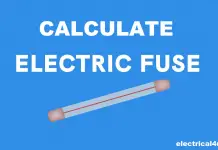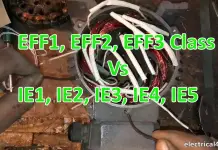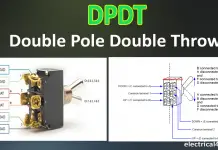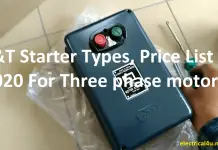What is Tariff:
A tariff is nothing but a charging a person for the consumption of electricity. It is also called a scheduled rate or charges. The main purpose of the tariff is to recover the capital investment and maintaining the service without any interruption.
Types of Tariff
There are 10 different types of tariff is in practice for collecting electricity bill from the consumer. They are
- Flat demand tariff
- Simple tariff
- Flat tariff
- Step rate tariff
- Block rate tariff
- Two-Part Tariff
- Maximum demand Tariff
- Power Factor Tariff
- Three-Part tariff
- Off-peak Tariff.
Let see the detail about different types of tariff.
Flat demand Tariff:
In which the consumer shall be charged based in their connected load. Flat demand tariff is initiated for helping poor people (Below Poverty Line – BPL). In India, having up to 0.2kW with the average consumption of 30 units per month consumer shall come into these types of tariff.
Let us consider the consumer’s connected load is P(connected load) in KiloWatt and R is the rate per kW means, the electricity bill connected by using below formula
Electricity Bill for Flat demand tariff= P(connected load) x R
The advantage of flat tariff is,
- Less initial cost and we do not need to install metering equipment
- Poor People will be benefited
Simple Tariff:
It is straight tariff in which the consumer shall be charged at one rate for all the consumption. In this type of tariff, the per-unit cost is the same for 1 to infinity units.
Mathematically, your electricity cost is equal to the product of the total power consumption and per unit rate.
Generally, the per-unit rate will be calculated from below formula,
Cost per kWh = (Annual Fixed cost + Annual Operating cost )/ Total unit consumption.
Example:
In India, Jharkhand state has a simple tariff of ₹ 4.2 per unit.
Flat Rate Tariff:
In this tariff, the consumer shall be categorized based on which the electrical energy is used. Example, domestic, commercial, industrial, hostels, housing board etc. are charged in different charges.
Also if the same consumer uses electricity for different application means, the electricity provider installs the energy meter for both areas and will be billed with different rates.
For calculating rate per unit, load factor and diversity factor shall be considered.
Advantages:
- Extra revenue for the same consumption
- Easy to understand
Disadvantages:
- Additional meter shall be installed
- Dishonesty
Step-Rate Tariff:
Step rate tariff is the most used type of tariff around the world. In India almost 29 states use step rate tariff. It is also called as slap tariff. In this type of tariff, the consumer shall be charged with different prices for a different level of consumption.
i.e look at the tariff rate of Telangana state, there are different steps with the different slaps.
| Scheme | Unit | Per unit(₹) |
| A | 0-50 | 1.45 |
| B | 51-100 | 2.6 |
| 0-100 | 3.3 | |
| 101-200 | 4.3 | |
| C | 0 -200 | 5 |
| 201-300 | 7.2 | |
| 301-400 | 8.5 | |
| 401-800 | 9 | |
| >800 | 9.5 |
Block tariff:
The energy consumption will be divided into different blocks at a different price. i.e the price for the first block will be higher and the second block will be less.
Example:
For the consumption of the first 1000 units, the per-unit cost will be ₹ 5 means, for the next 500 units, the per-unit cost will be ₹ 4.
It is also called as a sessional tariff. The power sector offers such tariff when they have excess power.
Two-part tariff:
In that, the tariff is calculated based on the consumer actual consumption along with the connected load per kW. Simple words,
The total electricity charges = electricity bill + Fixed charges (connected load * rate per kW)
Or
In India, some of the states are charging the consumer based on a two-part tariff.
Example: Gujarat.
Maximum demand tariff:
Maximum demand tariff is in practice at the commercial and industrial level consumers. The total maximum demand will be metered by the maximum demand meter. The consumer will be charged electricity bill along with the maximum demand.
Example:
In Karnataka state, the KPTCL charges 267 per kVA of maximum demand. Hence your electricity bill be will be the sum of the energy bill and MD charges.
Power factor Tariff:
In Power factor tariff, the load power factor will be considered. The power sector will give the upper and lower limit of the power factor. Upon exceeding or lowering the said threshold, the consumer will be charged. In this, reactive power will be accounted through the reactive power meters. It is also called as penalty tariff.
Hence, the total electricity bill amount is equal to the summation of the electricity bill (kWh) and the kVARh.
Electricity bill = kWh Bill + kVARh Bill
This type of tariff is in practice in Tamilnadu and Karnataka state. They are charging or put the penalty for the consumer is having a poor factor.
Three-part tariff:
A three-part tariff is nothing but a charging a consumer based on their consumption, maximum demand and fixed cost. Hence your electricity bill can be calculated as below formula,
Electricity Bill = kWh + Fixed charges + Maximum demand
Off-peak tariff:
An off-peak tariff is nothing but a rate will be varied per block basis (each interval). This types of the tariff are only in practice at the industry level. The consumer shall contact the seller directly through their official portal.
Example: IEX. They are selling the power in 15mints block interval.
The rate is depending upon the total number of bids. i.e the rate per unit cost at peak hours 10 to 12 will be very high. Sometimes it varied from ₹ 6 to 16 INR.
At the same time, night hour from 1 AM to 4 AM, the price will be ₹ 2 to 5. Hence the consumer shall be encouraged to consume power during night time.


![What is Normally Open & What is Normally Closed [Video Included] What is NO and NC](https://www.electrical4u.net/wp-content/uploads/2020/09/What-is-NO-and-NC-218x150.png)










Easy to learn
Very glad to Hear